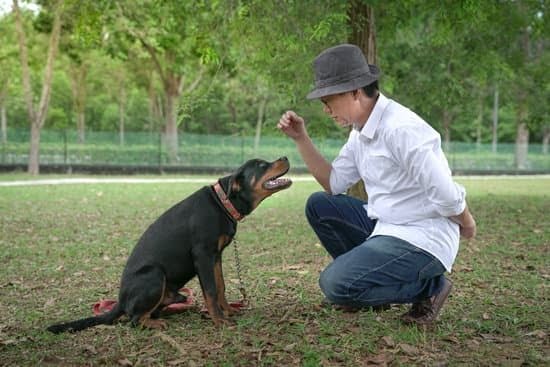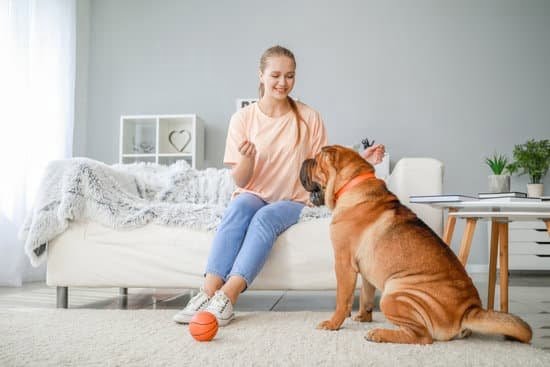When it comes to training a dog, every owner faces unique challenges. However, dealing with an aloof dog can be particularly daunting. These dogs often display characteristics that make them seemingly uninterested or distant, resulting in difficulty when it comes to forming a strong bond and effective training. In this article, we will delve into the intricacies of training an aloof dog and explore strategies to help owners overcome these challenges.
To begin, it’s important to understand what exactly defines an aloof dog. These dogs typically exhibit behaviors such as avoiding physical contact, being disinterested in attention or affection, and maintaining a certain level of independence. While some dogs are naturally more reserved than others, there can be various reasons for their aloofness.
For instance, certain breeds may have been bred with traits that contribute to their independent nature. Additionally, past experiences or traumas could play a role in shaping a dog’s aloof behavior.
Building trust is at the core of training an aloof dog successfully. Without establishing trust, gaining their attention and cooperation can be incredibly challenging. This requires creating an environment where your dog feels secure and comfortable. Providing them with a consistent routine and positive reinforcement techniques will help lay the foundation for building trust.
In the upcoming sections of this article, we will explore different aspects of training an aloof dog in greater detail. From understanding the root causes of their behavior to implementing socialization techniques and seeking professional assistance if needed, we will provide practical tips and insights to help turn your relationship with your aloof dog into one of mutual trust and understanding.
So let’s embark on this journey together and discover how we can unlock the potential hidden within every aloof dog.
The Importance of Building Trust with Your Aloof Dog
The importance of building trust with an aloof dog cannot be overstated. Trust is the foundation for successful training and can significantly impact your dog’s overall well-being. When a dog is aloof, they may have difficulty forming strong bonds with their owners or other people they encounter. This can make training more challenging. However, by focusing on building trust, you can create a secure and comfortable environment for your dog to learn and thrive.
Significance of Trust in Training Aloof Dogs
Trust forms the basis of any healthy relationship, including the one between you and your dog. Without trust, it becomes difficult for dogs to feel safe and comfortable enough to engage in training exercises. An aloof dog may have had past experiences that have caused them to be wary of people or new situations. It is essential to approach their training with empathy and patience, understanding that gaining their trust will take time.
Building trust with an aloof dog requires consistency, positive reinforcement, and respect for their boundaries. Start by observing your dog’s body language and responding appropriately. Allow them to approach new situations at their own pace and avoid forcing interactions that may cause fear or discomfort.
Establishing a Secure and Comfortable Environment
Creating a secure environment for your aloof dog is crucial in building trust. Provide them with a designated area where they feel safe, whether it’s a crate or a quiet corner in the house. Make sure this area is always available to them so they can retreat when they need some alone time.
Additionally, establish consistent routines for feeding, exercise, and playtime to give your aloof dog a sense of predictability and security. Consistency helps build trust as dogs learn what to expect from their environment and develop confidence in their daily routine.
Understanding the Root Cause of Aloof Behavior
When training an aloof dog, it is essential to understand the root cause of their aloof behavior. By analyzing possible factors contributing to your dog’s aloofness and recognizing any previous traumas or negative experiences, you can develop a training approach that addresses their specific needs and helps them overcome their aloof tendencies.
One possible factor that may contribute to an aloof dog’s behavior is genetics. Some breeds are naturally more independent and reserved, which can manifest as aloofness. These dogs may have been bred for specific purposes like guarding or herding, where being distant or cautious towards strangers was advantageous. It is important to consider your dog’s breed and understand any inherent traits associated with it.
Another factor that could contribute to a dog’s aloof behavior is early socialization experiences. If a dog did not have positive interactions with people or other animals during their critical socialization period (usually between 3-14 weeks of age), they may become fearful or suspicious in new situations. Traumatic experiences or lack of exposure during this critical period can have a lasting impact on an animal’s behavior and may contribute to their aloofness.
To better understand the root cause of your dog’s aloof behavior, it is crucial to observe their body language and investigate any potential triggers or situations that make them uncomfortable. Taking notes on your dog’s reactions can help identify patterns and understand what specifically causes them to display aloof behavior. This information can then be used to tailor your training methods accordingly.
Understanding the underlying reasons behind your dog’s aloof behavior is essential for successful training. By identifying possible genetic influences and recognizing any past negative experiences, you can design a training plan that addresses their specific needs and helps them overcome their reservations. Building trust starts with understanding, empathy, and patience, setting the foundation for a healthy relationship with your beloved furry companion.
| Factors Contributing to Aloof Behavior | Description |
|---|---|
| Genetics | Some breeds are naturally more independent and reserved, manifesting as aloofness. |
| Early socialization experiences | Negative or lack of positive interactions during the critical socialization period can contribute to a dog’s aloof behavior. |
| Past traumas or negative experiences | Dogs may display aloofness due to previous traumatic experiences or negative encounters with people or other animals. |
Creating a Positive Training Environment
When it comes to training an aloof dog, creating a positive training environment is crucial for their success. Dogs that are aloof by nature tend to be more wary and cautious, making it important to establish a safe and comfortable space for them. By setting up a designated training area and utilizing positive reinforcement techniques, you can create an environment that encourages learning and helps your dog overcome their aloof behavior.
Setting up a designated training area
One of the first steps in creating a positive training environment for your aloof dog is to establish a designated training area in your home. This space should be free from distractions and provide a quiet and secure atmosphere for your dog to focus on training exercises. Choose an area where you can easily control the surroundings and minimize outside disturbances.
Ensure that the space is well-ventilated, adequately lit, and has enough room for both you and your dog to move comfortably during training sessions. Keep the area clean and organized, removing any objects that could be potential hazards or distractions. Having a dedicated training spot not only helps your dog associate that space with learning but also aids in building consistency in their training routine.
Utilizing positive reinforcement techniques and rewards
Positive reinforcement is key when working with an aloof dog as it motivates them to engage in desired behaviors rather than focusing on punishment or correction. Using rewards such as treats, toys, or verbal praise can help reinforce the behavior you want to see from your dog. Be sure to offer these rewards immediately after your dog successfully performs the desired action so they can make the connection between their actions and the reward.
In addition to rewards, another useful technique is clicker training. A clicker is a small handheld device that makes a distinct clicking sound when pressed. The idea behind clicker training is that you “mark” the correct behavior with the noise of the clicker and then follow it up with a reward. This consistent marker helps your dog understand exactly what they are being rewarded for, making the training process more effective.
It’s important to remember that utilizing positive reinforcement techniques requires consistency and patience. Your aloof dog may need more time to warm up to the training process, so be patient if progress seems slow initially. With time and practice, your dog will begin to associate the training environment with positive experiences, leading to more successful training sessions.
Developing Patience and Persistence in Training
Training an aloof dog requires a great deal of patience and persistence. These dogs often have a independent and reserved nature, which can make the training process more challenging. However, with the right approach and mindset, it is possible to build a strong bond with an aloof dog and achieve successful training outcomes. This section will explore the importance of patience in training an aloof dog and provide tips for staying consistent and persevering through setbacks.
Patience is key when training an aloof dog. These dogs may take longer to warm up to new people, environments, or training methods. It is important to understand that their aloofness is not a reflection of disobedience or stubbornness, but rather their natural temperament. Rushing the training process or expecting quick results can undermine trust and hinder progress.
To effectively train an aloof dog, it is crucial to stay consistent. Consistency in commands, rewards, and expectations will help your dog understand what is expected of them. Repeat commands patiently until they are understood, and reward your dog consistently for desirable behaviors. Additionally, consistency in training sessions can help establish a routine for your dog, which contributes to feelings of security and comfort.
Despite potential setbacks or challenges during training sessions with an aloof dog, it is important to persevere. Recognize that progress may be slow at times, but each small step forward should be celebrated. By maintaining a positive attitude and continuing to work with your aloof dog regularly, you can build their confidence over time.
Here are some key tips for developing patience and persistence when training an aloof dog:
- Set realistic expectations: Understand that training an aloof dog takes time and effort.
- Stay calm: Avoid frustration or impatience during training sessions as this can negatively impact your dog’s learning experience.
- Break tasks into smaller steps: Focus on one command or behavior at a time, allowing your dog to master each step before moving on.
- Take breaks when needed: Recognize when your dog may need a break during training sessions to prevent exhaustion or overwhelm.
- Stay consistent with routines: Consistency in daily routines and training sessions helps build trust and familiarity for your aloof dog.
By developing patience and persistence in training, you can create an environment that encourages your aloof dog to learn and grow. Understanding the unique personality and needs of an aloof dog is key to their success. With time, effort, and a positive mindset, you can nurture their potential and establish a strong bond based on trust and understanding.
| Tips for Developing Patience and Persistence |
|---|
| Set realistic expectations |
| Stay calm during training sessions |
| Break tasks into smaller steps |
| Take breaks when needed |
| Stay consistent with routines |
Implementing Socialization Techniques for an Aloof Dog
When training an aloof dog, one of the key steps to consider is implementing socialization techniques. Socialization plays a crucial role in helping your dog overcome their aloof behavior and develop better coping skills in various situations. By gradually introducing your dog to new people, animals, and environments, you can help them become more comfortable and confident in unfamiliar settings. Here are some strategies to effectively implement socialization techniques for an aloof dog:
- Gradual Exposure: Start by exposing your aloof dog to new experiences in a controlled and gradual manner. This could include introducing them to different individuals one at a time or gradually increasing the duration of interactions with other dogs. Begin with calm and well-behaved individuals and progress at a pace that your dog feels comfortable with.
- Positive Reinforcement: Use positive reinforcement techniques during socialization sessions to create positive associations for your dog. Reward them with treats, praise, or play whenever they exhibit calm and relaxed behavior around new people or animals. This will help reinforce positive connections with unfamiliar stimuli.
- Controlled Environment: Create a controlled environment during socialization sessions to ensure the safety of both your dog and others involved. Use a leash or harness to maintain control over your dog’s movements while allowing for supervised interaction. Consider utilizing designated off-leash areas where your dog can safely explore while being closely monitored.
- Desensitization Training: Incorporate desensitization training into your socialization efforts by gradually exposing your aloof dog to stimuli that typically triggers their aloof behavior. For example, if they are nervous around loud noises, start by playing recordings of those noises at low volumes and gradually increase the volume over time as they become more comfortable.
- Playdates and Group Activities: Arrange playdates or group activities with other well-behaved dogs to provide opportunities for social interaction in a controlled environment. This can help your aloof dog learn appropriate social behaviors by observing and interacting with other dogs.
Remember, patience is key when implementing socialization techniques for an aloof dog. Each dog progresses at their own pace, so allow them the time they need to build confidence and trust in new situations. Celebrate small victories along the way and continue to provide positive reinforcement to boost their motivation. By implementing effective socialization techniques, you can help your aloof dog become more comfortable and sociable, nurturing their full potential.
Building a Strong Bond with Your Aloof Dog
Building a strong bond with an aloof dog is crucial for their overall well-being and successful training. Aloof dogs often have a more independent and reserved nature, making it important to establish trust and a connection with them. Here are some strategies for building a strong bond with your aloof dog:
- Quality Time and Attention: Spending quality time with your aloof dog is essential for developing a bond. Engage in activities that your dog enjoys, such as going on walks, playing fetch, or simply relaxing together. Show them love and attention, as this will allow them to feel secure in your presence.
- Bonding Activities: Participating in bonding activities can help build trust and strengthen the relationship between you and your dog. These activities can include obedience training sessions, puzzle games, or even scent work. Find activities that stimulate their mind and provide opportunities for positive interactions.
- Understanding Your Dog’s Needs: Each dog has unique needs, including those that are aloof by nature. Take the time to observe and understand what makes your aloof dog comfortable or uncomfortable. Recognize their boundaries and respect their personal space when necessary. By understanding their individual needs, you can create an environment where trust can flourish.
- Positive Reinforcement: Use positive reinforcement techniques to reward desired behaviors from your aloof dog. This could be through treats, praise, or playtime whenever they exhibit behavior that you want to encourage. Positive reinforcement creates a positive association with training and helps strengthen the bond between you.
- Communication: Effective communication is essential in building a strong bond with an aloof dog. Learn to read their body language and understand their unique ways of communicating with you. This will help create clarity in your interactions and strengthen the level of understanding between you both.
By implementing these strategies consistently over time, you can gradually build a strong bond with your aloof dog based on trust, understanding, and mutual respect.dd.
Working with a Professional Trainer or Behaviorist
Training an aloof dog can be a challenging and complex task, especially when dealing with deeply ingrained behaviors. In some cases, seeking the help of a professional trainer or behaviorist can greatly benefit both you and your dog. These experts have the knowledge and experience to understand the unique needs of aloof dogs and develop effective training strategies tailored to their personality.
When selecting a professional trainer or behaviorist for your aloof dog, it’s important to find someone who specializes in working with this specific type of behavior. Look for trainers who have experience in handling aloof dogs and are familiar with the challenges that may arise during the training process. Ask for referrals from other dog owners or consult local veterinary clinics for recommendations.
During the initial consultation with a professional trainer or behaviorist, they will assess your dog’s aloofness and develop an individualized training plan based on their observations. They will often use positive reinforcement techniques and provide guidance on how to create a positive training environment at home. Additionally, these professionals can offer valuable insights into understanding the root cause of your dog’s aloof behavior, helping you develop strategies to address any underlying issues.
Working with a professional can also provide you with emotional support and guidance throughout the training journey. They can offer reassurance during setbacks or moments of frustration and keep you motivated to continue working towards progress. Remember that consistent communication between you, your dog, and the trainer is crucial in achieving desired results.
While enlisting the help of a professional is important, it is equally essential for you as the owner to be actively involved in the training process. Building trust takes time, and your active participation in training sessions will strengthen your bond with your aloof dog. Together with the professional trainer or behaviorist, you can navigate through any challenges that arise while nurturing your aloof dog’s potential.
Celebrating Small Victories and Progress
Training an aloof dog can be a challenging process, but by celebrating small victories and progress, you can help your furry friend become more engaged and motivated in their training. Recognizing and acknowledging your dog’s accomplishments is essential for building their confidence and reinforcing positive behaviors.
One way to celebrate small victories is by using positive reinforcement techniques. When your aloof dog follows a command or exhibits the desired behavior, reward them immediately with treats, praise, or affection. This reinforces the idea that good behavior results in pleasant outcomes. By consistently rewarding positive actions, you can encourage your dog to repeat those behaviors in the future.
Another key aspect of celebrating progress is setting realistic goals for your aloof dog. Break down the desired behaviors into smaller, achievable steps. For example, if you’re working on getting your dog comfortable with strangers, start by having them spend short periods of time near someone they don’t know. Gradually increase the duration and proximity as your dog becomes more comfortable. Each successful interaction should be recognized and celebrated as a step closer toward the overall goal.
It’s important to remember that progress may not always be linear when training an aloof dog. There may be setbacks or instances where they regress in their behavior. During these times, it’s crucial to stay patient and persistent. Keep supporting and encouraging your dog through these challenges instead of becoming discouraged or frustrated. Celebrate even the smallest steps forward, as each one contributes to their growth and development.
By celebrating small victories along the way, you are not only motivating your aloof dog but also creating a positive training environment that fosters engagement and trust. Through patience and consistency, you can help your furry companion overcome their aloof tendencies and build a stronger bond between you both. Embrace the journey of training an aloof dog, appreciating their unique personality every step of the way.
Conclusion
In conclusion, training an aloof dog requires patience, consistency, and understanding. It is important to recognize and embrace their unique personality traits and work towards building trust and a strong bond with them. Trust is a crucial element in training aloof dogs, so creating a secure and comfortable environment for them is essential. By establishing a designated training area and utilizing positive reinforcement techniques, such as rewards and treats, we can encourage desired behaviors.
Understanding the root cause of aloof behavior is also vital in effectively training these dogs. Analyzing possible contributing factors, such as past traumas or negative experiences, can help us tailor our training approach accordingly. Gradually introducing the dog to new people, animals, and environments can help counterbalance their aloofness through positive socialization experiences.
While it may be challenging at times, it is important to remain patient and persistent when training an aloof dog. Setbacks are part of the process, but staying consistent will yield incremental improvements over time. Building a strong bond with these dogs involves spending quality time with them, engaging in bonding activities that they enjoy, and understanding their individual needs.
Seeking the assistance of a professional trainer or behaviorist experienced in handling aloof dogs can greatly benefit both you and your pet. They can provide guidance and support in navigating any challenges that may arise during the training process.
It is important to celebrate small victories along the way and acknowledge your dog’s accomplishments. These celebrations not only boost their confidence but also motivate them to continue improving. Remember to embrace the journey and nurture your aloof dog’s potential by providing them with love, patience, consistency, understanding, and plenty of opportunities for growth. With dedication and care, you can develop a deep connection with your aloof dog while helping them reach their full potential.
Frequently Asked Questions
How do you deal with an aloof dog?
Dealing with an aloof dog can be a bit challenging, but it’s important to approach them with patience and understanding. Building trust is crucial, so taking things slow and giving the dog space when needed is key. It’s vital not to force interactions or overwhelm them with attention.
Instead, give them time to observe their surroundings and gradually introduce positive experiences. Engage in gentle play sessions or walks, using rewards and praise to reinforce positive behavior. Consistency is essential in establishing a routine that makes the aloof dog feel safe and secure.
What does it mean if a dog is aloof?
When a dog is described as aloof, it means they tend to be distant or reserved in their behavior towards people or other animals. Aloof dogs may display less interest in seeking attention or interaction from their human companions, often preferring solitude or independence during certain times.
This characteristic is influenced by factors such as genetics, breed traits, early socialization experiences, and individual personalities. It’s important not to mistake aloofness for aggression or fearfulness; aloof dogs simply have a more reserved disposition.
How do you train an uninterested dog?
Training an uninterested dog requires patience and finding motivation that captures their attention. Start by identifying what truly motivates the dog – whether it’s food rewards, playtime, or praise – and incorporate this into training sessions. Use high-value treats that they find irresistible as incentives for desired behaviors like sitting or staying on command.
Keeping training sessions brief yet consistent helps maintain their focus without overwhelming them. Breaking down tasks into smaller steps can also make training more manageable for an uninterested dog. Additionally, always end on a positive note with plenty of praise and rewards to reinforce the training’s success and build motivation over time.

Welcome to the blog! I am a professional dog trainer and have been working with dogs for many years. In this blog, I will be discussing various topics related to dog training, including tips, tricks, and advice. I hope you find this information helpful and informative. Thanks for reading!





